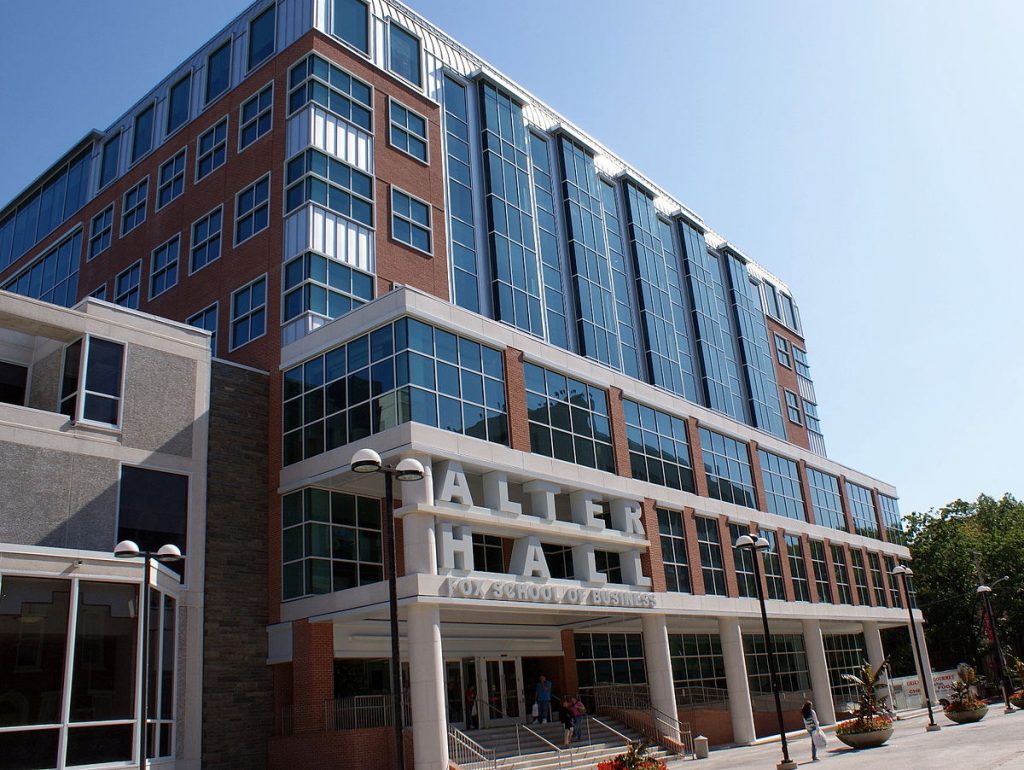New Ryerson University Research Finds Immigrants Take Greater Business Risks

A new study from the Ted Rogers School of Management at Ryerson University investigates the role immigrant entrepreneurs play in global markets, finding that greater business risk does isn’t always worth the reward.
What Are The Most Valuable Toronto MBA Programs?

For prospective MBAs, looking at the price tag of earning a degree can be startling- and may even deter talented business leaders from pursuing an advanced education. The fear is certainly justified: an MBA from some of North America’s top business school can reach upwards of $100,000.
Yet, when considering the well-recorded increase that most professionals witness in their salary after earning an MBA, along with a greater likelihood of finding employment, the seemingly impossible cost of an MBA can seem more within reach.
Factors like the cost of a degree, salary increase after graduation and employment rate of graduates are all key numbers that must be considered together before one can determine the true cost of a degree. Below, we take a glance at these different numbers and round up the Toronto MBA programs that provide the best return on investment.
Ivey Business School – Western University Canada
The Ivey Business School at Western University Canada MBA program began in 1950, and has since established itself as one of the best offerings in the world. The business school’s rich legacy has been recognized again and again by the likes of Bloomberg, which touted its MBA as the 11th best international MBA program in 2017. Ivey, with its main teaching center on Western University’s campus in London, Ontario, offers a variety of MBA experiences, such as an full-time, Accelerated, and Executive MBA. The Tangerine Leadership Centre in Toronto’s downtown business district also offers EMBA courses through the Ivey Business School.
The full-time MBA at Ivey is a 12-month program that costs $88,250 to attend for domestic students and $101,500 USD for international applicants. According to the most recent Ivey employment report, about 91 percent of the 169 students in the Class of 2017 earned a job opportunity shortly after graduation, reporting an average salary of $103,560. More than one-third of the Class of 2017 also earned a singing bonus upon employment with a median value of $15,000. Signing bonuses for Ivey MBA grads ranged as high as $45,000 alone, proving that even with high price tag, the degree can immediately pay off.
Ivey Return on Investment (In USD)
| Ivey MBA Tuition | Median Signing Bonus | Median Annual Salary |
|---|---|---|
| $88,250 | $15,000 | $103,560 |
Schulich School of Business – York University
The Schulich School of Business at York University offers students a number of ways to pursue an advanced business education, from full-time, Executive, and International MBA programs as well as offering Master’s degrees in accounting, finance, business analytics, and more. The Schulich International MBA is the first of its kind in Canada, and the Kellogg-Schulich Executive MBA is North America’s first ever cross-border executive MBA degree. However, length of programs should be taken into consideration, since it will determine the time without a full-time income; an important distinction for students that are looking to enter the workforce as soon as possible. At 16-20 months, an MBA at Schulich will take slightly longer to earn than year-long programs like at Ivey.
Roughly 89 percent of graduates from Schulich’s MBA programs find a job within three months, earning an average base salary of $91,860 USD and an average singing bonus of $12,050. Full-time MBA students at Schulich will pay a tuition of $77,900 during the life of the degree, while part-time students pay $81,000. Meaning, grads typically earn about $10,000 more in their first year of employment than the entire cost of the program.
Schulich Return on Investment (In USD)
| Schulich MBA Tuition | Median Signing Bonus | Median Annual Salary |
|---|---|---|
| $77,900 | $12,050 | $91,860 |
Rotman School of Management – University of Toronto
The Rotman School of Management at the University of Toronto can boast of origins dating all the way back to 1901, when the university first established a diploma program in commerce. By 1972, the School of Business was an official part of the university, and hasn’t stopped growing since. Today, the Rotman School of Management has become universally recognized by the likes of Financial Times the and Bloomberg as one of the best business schools in the country. Located in downtown Toronto, Rotman offers a two-year, full-time MBA degree, but also more flexible options such as part-time morning and evening MBA programs, executive MBA, and an 18-month Global Executive MBA.
The two-year, full-time MBA tuition at Rotman comes with a price tag of $101,350 CAD ($74,999 USD). However, graduates—80 percent of whom typically find employment within three months after earning their degree—saw a median base salary of $85,000 and median signing bonus of $13,500. This salary increase seems to be typical of MBA graduates in Canada, so considerations of employment rate and program duration may be most important when evaluating Return on Investment for top programs in Canada.
Rotman Return on Investment (In USD)
| Rotman MBA Tuition | Median Signing Bonus | Median Annual Salary |
|---|---|---|
| $74,999 | $13,500 | $85,000 |
Oxford Saïd MBA Students Suggests a Few 2018 Resolutions

The start of every year is a great time to reflect on what went well the previous year—and how you can improve in the next. Indeed, the time-honored tradition of setting resolutions for the new year can be especially valuable for MBA students and applicants. Whether you’ve just completed your first or third semester of an MBA program or are still working on perfecting your MBA applications, there are always a few resolutions that can help make the most of how ever much of your MBA experience is still ahead of you.
We’ve compiled a list of business school New Year’s resolutions from current MBA students at the University of Oxford Saïd Business School. While some are specific to Saïd’s program, they all represent great business school advice you’d do well to read regardless of whether you haven’t yet started or are closing in on graduation.
Business School New Year’s Resolution One: Balance Your Time
Whether you’re busily working on your applications, are about to start your first semester in an MBA program, or whether your final semester stretches out in front of you, learning how to balance your time is key to success in any MBA program. Marla Woodward (MBA ’18) explains how important it is to take care of all aspects of your life.
“To balance your time, pick an activity for your mind, an activity for your body, and an activity for your spirit,” Woodward wrote in a blog. “For example, this term I’m leading a project for the Oxford Strategy Group for my mind, I’m participating in fencing for my body, and I’m maintaining weekly family dog walks for my spirit.”
Containing the amount of time spent on schoolwork is also important. During your MBA, you’ll be presented with countless readings and assignments. Each class will load your schedule with things to do, and the best way to achieve success is to plan out how you’ll budget your time to get everything done for class while not overwhelming your life.
“Map out all readings, exams, and group projects in your calendar, so you know what’s coming when,” Woodward recommends. “This will help you anticipate how to budget your time when you have multiple group projects all due on the same day, and it will also come in handy when, heaven forbid, you can only find time for a portion of the readings and you need to decide which are the most valuable.”
Business School New Year’s Resolution Two: Take Advantage of Your Network of Classmates
This resolution is especially important for applicants who are preparing to start an MBA in 2018. Instead of thinking of it as entering a world of strangers, Bremen Leak (MBA ’18) advocates taking the attitude of poet W.B . Yeats who said, “There are no strangers, only friends you have not met yet.”
When Leak first started his studies at Oxford Saïd, it seemed like everything that could go wrong did. He was waitlisted. Then, once he was finally accepted, his housing fell through, and he was left without a place to live. But after starting school, he was offered a place to live by a classmate he had just met. And this was just the first of many times that he says a classmate helped him out.
“Since my first day inside the business school, I’ve watched my classmates—some 330 MBAs from 60 countries—band together to help one another succeed,” Leak wrote in a blog. “They’ve divvied up reading assignments and formed study groups and tutoring sessions. They’ve shared jokes, drinks, encouragement, and advice… Who were these people but strangers just a few months earlier?”
If it wasn’t for the fact that Leak had learned to treat his classmates like close friends, no matter how long [or short] their acquaintance, he could have missed out on many opportunities.
Business School New Year’s Resolution Three: Use Every Resource Available to You
From the moment you first start considering an MBA, there will be countless resources available to help you make the best decision. Here at Clear Admit, we offer dozens of articles each week containing the latest MBA news, advice from admissions teams, and interviews with current students. Of course, there are also the rankings from outfits like U.S. News & World Report, the Financial Times, Bloomberg Businessweek, and others to help you find the best program for you.
Perhaps most important of all are the resources provided by individual MBA programs themselves. There are the websites, of course, and the information sessions and the school fairs. But many applicants tell us that the most invaluable resources provided by the schools are the students themselves and everything you encounter on campus is a visit is in any way possible.
That’s what Nikhil Dugal (MBA ’18) discovered when he first started considering an MBA. In fact, the availability of resources was one of the main reasons he chose Oxford Saïd—in particular, the resource of the Skoll Centre for Social Entrepreneurship.
“Coming from a background in economics and math, I wanted to study business in a place that was focused on supporting social entrepreneurs and actively involved in the changing narrative on the nature of business. Due to this reason, I had a very specific list of MBA programs,” Dugal explained on a Skoll Centre blog. “Saïd Business School was at the top of this list, especially due to the countless resources they offer to social entrepreneurs and the presence of the Skoll Centre.”
Those resources helped Dugal receive the Skoll Scholarship, which provided him with the opportunity to pursue his goals without worrying about his finances. Since starting his MBA, there have been many other opportunities.
“Over the next year I plan to use all the resources we are offered here, including programs such as Map the System, Skoll Academy, and Skoll Venture Awards to refine the mission of my organization and explore levers for change to help us scale our impact,” Dugal wrote. “I’ve had the opportunity to attend a few sessions at the Skoll Academy already and am extremely impressed with the program the Centre has been able to put together as an alternative to the Consulting Development Program and the Finance Lab offered to the rest of the MBA class.”
With just a week into the New Year, there’s plenty of time to make good on your business school resolutions. What are you waiting for?
This article has been edited and republished with permissions from our sister site, Clear Admit.
From Just One Woman to 39 Percent of the Class—and Other Ways LBS Has Changed Over the Past 50 Years

The 2017-18 academic year marks the 50th anniversary of the MBA program at London Business School (LBS). Since 1968, the school has offered a two-year Master of Science (MSc) in Business Studies degree program—the original MBA—and has continuously refined its offerings since that time. In celebration of the 50-year mark, LBS is looking back at how far the program has come.
The Beginning
In 1966, two years after London Business School opened its doors, the school launched a two-year Master of Science (MSc) in Business Studies. The first class consisted of 35 men and just one woman, with the average age around 25 years old. The goal of the two-year degree was to prepare students for employment. In fact, according to the website, employment was seen as “one of the most significant aspects of the school’s progress at this stage of its development.”
After graduation, most students joined manufacturing firms, and a few went into merchant banking, management consultancy, and advertising. Their job functions included marketing and financial executives, planning personnel, and personal assistant roles.
As for the feedback on the first year of study, a report on the class stated, “The overall academic performance of the students during the year has been more than satisfactory. The course of studies is arduous and the number of hours of work required is much above average, imposing a considerable workload both on students and staff.”
The Early Years
In the early years of the program, growth was slow but steady. In 1971, the class size grew to 86 students and by 1975, 108 students were admitted, including 16 women. Throughout this time, LBS made various modifications to its program.
- In 1973, LBS introduced the International Management Program, which gave 10 students the change to study abroad in Paris or at New York University.
- In 1978, the International Management Program expanded to include Harvard, Stanford, Wharton, Chicago, and top European institutions.
The 1980s
The 1980s were a time of change for LBS and the MBA program. During these years, banking and finance overtook manufacturing as the top industry for graduates. In addition, LBS continued to increase its international reputation; about half of its class comprised non-British students by the end of the decade, with more 30 nationalities represented. Most importantly, the Class of 1987 was the first to be awarded an MBA rather than an MSc degree. In an annual report, the school stated, “This more accurately and effectively conveys the spirit of the program, and the type of qualifications our students are aiming for.”
- In 1982, LBS introduced a new part-time master’s program. The first class accepted 60 people and allowed students to complete their studies over two and a half to three years while still working.
- In 1984, three more U.S. schools joined the International Exchange Program including Dartmouth Tuck, MIT Sloan, and Northwestern Kellogg.
The 1990s
In the 1990s, LBS adopted a more flexible format for its MBA program. The school added increased training in “soft skills” and introduced computer-based management simulation games. The class size also increased to 271 students, with 79 percent of students coming from outside the United Kingdom. Consulting became the top choice for graduates, and manufacturing shrunk to just 11 percent.
- In 1992, LBS introduced a language requirement where students must be fluent in English and one other language to graduate. In addition, the part-time master’s was re-launched as the Executive MBA.
- By 1996, entrepreneurship became an important part of the program, and the school launched several electives with an entrepreneurial focus, including “Small Business Management” and “Financing the Entrepreneurial Business.”
- 1999 was the first Financial Times Global MBA ranking, and LBS ranked #1 in Europe and #8 in the world—the only non-U.S. school in the top 10.
The 2000s
By the 2000s, LBS had become a global leader in MBA education—and in 2009 it became the first non-U.S. school to top the Financial Times ranking. The MBA program was reformatted for increased flexibility, allowing students to graduate in 15 to 21 months. The class size also increased to 315 students, with 89 percent of the class from 59 countries outside the United Kingdom.
- In 2001, LBS ranked as the best Global MBA by the Financial Times, and Forbes ranked LBS as #1 in Europe and #2 in the world for return on investment.
- In 2003, LBS became the first European school to join the Forté Foundation to increase women in business, and in 2005, women made up 22 percent of the class.
The 2010s
In the last decade, London Business School once again revised its MBA program to give students even greater flexibility. The school also continued to increase its size, welcoming 468 students by 2018—12 times the size of the first class in 1968. In addition, women now make up 39 percent of the MBA class, and students represent 77 different nationalities.
- In 2010, LBS started its Incubator Program to help entrepreneurs. As of 2017, 58 businesses have completed the incubator, raising more than £31 million and creating 440 full-time jobs.
- In 2012, LBS launched the Global Business Exchange (GBE), giving students the opportunity to spend a week in another country with options ranging from South Africa to the United States.
- In 2016, LBS completed its first fundraising campaign, raising £125 million.
To learn more about the 50th anniversary celebration of London Business School’s MBA, visit the school website.
This article has been edited and republished with permissions from our sister site, Clear Admit.
Amazon Talks About Its Success and Recruiting at London Business School

It’s not that surprising to hear about Seattle-based Amazon recruiting from top U.S. MBA programs such as the University of Michigan’s Ross School of Business, where it was the number-one recruiter in 2016, hiring 31 of the school’s MBA grads. What might be more surprising is the fact that Amazon is also a big recruiter at London Business School (LBS), where it snapped up 13 Class of 2016 MBA graduates, right behind BCG, McKinsey, and Bain. When speaking to students and alumni at an LBS event, Doug Gurr, Amazon’s U.K. country manager, said, “The U.K. is an amazing location to recruit great talent, and LBS is somewhere we find the talent we need.”
Currently, the United Kingdom is a prime location for Amazon, with more than 24,000 employees and 373,000 U.K. businesses as part of its marketplace, web, and publications services. This makes recruiting in the United Kingdom easily fit into Amazon’s founding principles, which include customer obsession, passion for invention, commitment to operational excellence, and long-term thinking. As Gurr admitted, “The biggest constraint on our growth is finding the right leaders to join us,” and LBS is known for producing quality MBA graduates and business leaders.
However, hiring in the United Kingdom isn’t the only key to Amazon’s success. Gurr explained that the company is also focused on unmet customer needs. For example, that’s how the Kindle came about. “The Kindle didn’t exist so we built it,” said Gurr. “We’d never built anything before, but we had passion and conviction about the quality of the idea. That was the genesis of our move into manufacturing hardware devices.”
Other inventions from Amazon include Alexa, its cloud-based voice service, as well as flying autonomous drones, and hundreds of other small improvements. To Gurr, it’s all these small things that make Amazon faster, simpler, and better than its competitors.
The thing to note according to Julian Birkinshaw, a professor of strategy and entrepreneurship at LBS, is that this slow growth can also mean slow profits. “In 2016, you generated US$136 billion (£102 billion) in revenues and a net income of US$2.4 billion (£1.8 billion), which is less than 2 percent,” Birkinshaw said. “That’s small, but that has always been the story.”
But, according to Gurr, that growth trajectory is exactly what the company wants. “We optimize free cash flow over the long term,” he explained. “The simple answer is that we’re willing to make deep, long-term investments—we don’t need an instant payback. We do what’s right for the customer and what’s right for the business.”
To read more about Amazon’s MBA graduate recruiting efforts, read the Financial Times article, “Amazon’s Shopping Spree at Business Schools.”
This article has been edited and republished with permissions from Clear Admit.
Fox Temple EMBA Jumps in New Financial Times Ranking

When it comes to MBA rankings, the Temple University Fox School of Business is usually remarked for its highly-praised Online MBA. But focusing solely on the business school’s remarkable digital offering overlooks its increasingly well-regarded executive business program.
Last month, the school earned an immense boost in the Financial Times 2017 Executive MBA program rankings, climbing up to 56th from 73rd overall last year—the highest spot in the school’s history. The annual list is typically dominated by joint EMBA programs, such as the Northwestern University Kellogg School of Management and School of Business and Management of The Hong Kong University of Science and Technology’s Kellogg-HKUST EMBA program, which came in 1st overall. In fact, only one non-joint EMBA—the Oxford Saïd School of Business’ EMBA—made it into the top 10.
The Fox School of Business EMBA program came in 10th overall among U.S.-only programs on the new list, as well as 7th among northeastern EMBA programs, and 2nd overall among business schools in Pennsylvania. FT praised the program in particular for it’s “global immersion experience” (ranked 3rd in the U.S.) and for progress students make three years after graduation (ranked 4th globally).
In a press release, Fox School of Business Dean Dr. M. Moshe Porat said, “These latest rankings from Financial Times are indicative of our program’s growing reputation, strength, and return on investment.”
“Further, global immersions and our worldwide partnerships afford students the opportunity to gain global business savvy and study internationally, all through an immersive learning experience,” he continues. “These details continue to set apart our program.”

The Fox School of Business at Temple University.
Michael J. Rivera, Ph.D., Associate Professor of Strategy and Entrepreneurship and Fox EMBA Academic Director, recently spoke on the why the school has seen its ranking ascension, saying, “It is not easy to boil the reason for Fox’s rise in the EMBA Financial times rankings to just one principle, but if I did, I would have to say that it is our commitment to continuous improvement across all areas of our programs.”
On the recent evolution of the program, fueling its incredible rise in the rankings, Rivera remarks, “Over the past three years, we’ve overhauled our program entirely. Repositioned with a strong understanding of the market, we strive to understand the value our students need us to deliver and be curricularly relevant in the eyes of industry.”
Like many of the world’s top-rated programs, the global experience factor of the Fox EMBA heavily contributes to its overall quality. Rivera, who teaches his Creativity, Entrepreneurial Thinking and Innovation Strategy course in multiple international locations, adds, “The Fox EMBA program has numerous campuses globally where we offer our program – Bogota, Lima, Paris, Casablanca, Shanghai, and Tokyo. Stopping at these various campuses is helpful because it keeps me connected with the students and gives me an opportunity to observe the various programs in action. The on the ground insight supports our ability to be aligned and work as a team, even though we are physically in different locations around the world.”
Breaking Down the Benefits
The 48 credit program’s benefits for students is fairly self-explanatory. Fox EMBA graduates earn an eye-popping $156,426 annual salary three years after graduation, as well as a $26,000 bonus increase by the end of the program.
For a business school that may not be casually grouped with Ivy League competition, Rivera believes the success of the EMBA and its graduates comes from the school “punching above its own weight.” This is possible, he says, “because of our dean who is truly entrepreneurial and innovative. His leadership has empowered people to drive change and doesn’t set boundaries on what is possible.”
The FT ranking notes that Fox EMBA grads have seen financial benefit increases across the board, from salary jumps and promotions (4th best among qualified EMBA programs), as well as increases in female and international board members.
Fox EMBA applicants typically join the program with 10 to 15 years of experience, with a limit of 90 students per academic year (45 per cohort). The program can be completed in as little as 16 months and a GMAT waiver is available for select applicants.
For more information on the Fox EMBA, click here.
